
The Convent Garden of the Church of the Redeemer on the Giudecca island opens to the public after five centuries, thanks to a research and restoration effort of its historical and botanical heritage, revealing the beauty and simplicity of this magical, timeless place.
A living organism in continuous growth and transformation, a pure beauty offered by nature that follows the seasons, a unique oasis where time and space seem suspended. St. Mark’s Royal Gardens, a place we are particularly attached to, is a monument which was given back to Venice in 2019 after a long and demanding restoration carried out by the Venice Gardens Foundation. The Foundation, in particular its president, Adele Re Rebaudengo, with the idea of promoting an action of research and recovery of a historical and botanical heritage of great importance in the city, used the word “Gardens”, choosing the plural to suggest the desire for a mission aiming at a systemic recovery.
And so it was. After the experience of the Royal Gardens, Adele Re Rebaudengo has embarked on a new challenge which is at the same time very hard and fascinating, finding a unique place of deep symbolic and spiritual value: the Compendium of the Convent Garden of the Palladian Church of the Most Holy Redeemer on the Giudecca Island that covers about one hectare from the Giudecca canal up to the back Lagoon. The conservative and philological restoration, carried out according to a rigorous scientific and historical method, with particular attention to the botanical culture developed over the centuries, has respected the original holiness of the place, making it possible to carefully use this wonderful green area in perfect agreement with the Capuchin fathers.
On October 26th, the Venice Gardens Foundation and the Capuchin Friars Minor were proud to inaugurate the Vegetable Garden of the Redeemer, revealing for the first time in five centuries the beauty and the simplicity of this magical and suspended place, a deep expression of the ancient Franciscan principles.
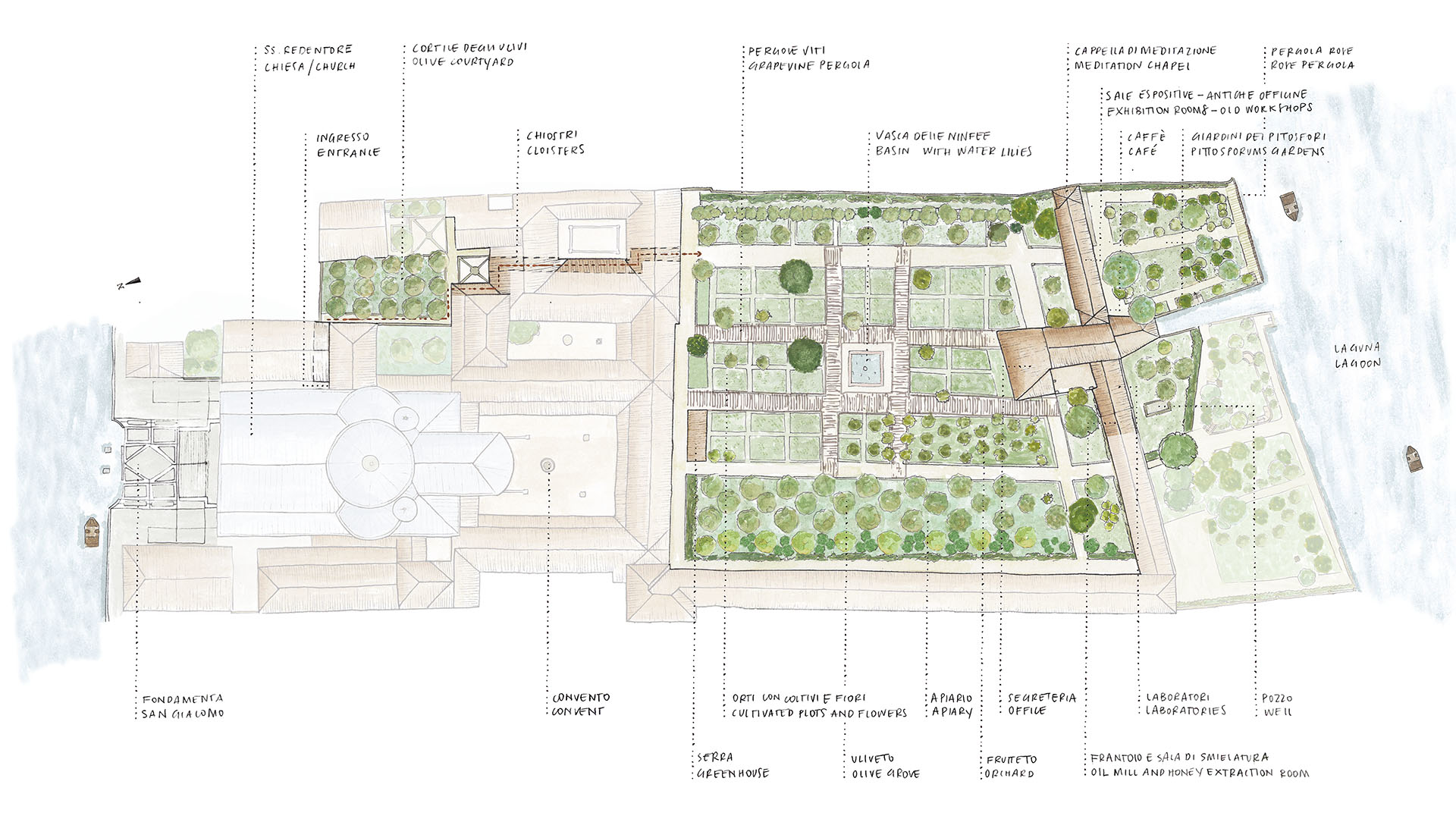
After the success of the Royal Gardens, you go on with your constant search for the development of monumental green spaces in Venice. What is the meaning of this new venture of yours?
For the Venice Gardens Foundation, restoring a garden, and in this case a vegetable garden, means not only taking care of the restoration and conservation of a historical, artistic and cultural heritage, but also and above all of the botanical and landscape heritage conservation. It means recognizing the major role that these places can play within the social and community fabric of a city, especially in a special city like Venice, with all its beauties and its problems. Restoring a garden is also a way to create a deep connection with nature, based on affinity, harmony and respect. Following these principles and ideals the Foundation began its activity in Venice by restoring the Royal Gardens it received in concession from the Public Property Agency and the City. It still continues to take care of these gardens which are flourishing day by day. Five years ago, we decided to extend our patronage mission to the Vegetable Garden of the Convent of the Most Holy Redeemer Church, a historic, symbolic place, a high expression of Capuchin spirituality, which we inaugurated on October 26, 2024, after over three years of hard work. Let me to underline that the project includes not only the restoration of the Garden but also its conservation and maintenance. The Foundation’s gardeners, directed by the head gardener Edoardo Bodi, follow specific maintenance and management programs based both on ancient knowledge and new techniques, in the full respect of nature, ecosystem and biodiversity. This includes organic cultivation as well as the adoption of natural practices for soil care, in order to promote plant resistance through the management of soil fertility, an aspect that we consider essential in this work and that is too often overlooked. We also pay close attention to saving natural resources, underlying the importance of recycling all existing elements. We have kept and reused everything we found in the Garden of the Redeemer sometimes changing its original meaning or use. The masegni (paving stones), for example, have been cleaned of concrete and used as curbs to mark out the squares composing the vegetable garden. We have chosen not to pave the walkways and to use instead a drainage material to allow water to be saved. The main principle the project is based on is an independent water supply system. As we are not connected to the aqueduct, we have dug a 120-meter-deep well. The ground water, which is very cold, is accumulated in settling tanks where it reaches room temperature before being used in the irrigation system. On the contrary, when we expect rainy days we stop drawing water from the well and use the tanks as reservoirs for rainwater collected from the roofs, thanks to a collection system called “rain barrels”. Finally, we use vegetable and organic waste in a sustainable way. Through an on-site composting process, over several months, this waste is turned into nourishment for the soil allowing its long-term fertility. These are, in short, our key principles for the restoration and conservation of a garden.

How did you discover this amazing new green area? And how was your initial relationship with the friars’ community?
About ten days after the inauguration of the Royal Gardens, on December 7, 2019, I showed up at the door of the Convent to ask Brother Stefano, representing the friars’ community, if he was willing to grant the Vegetable Garden to the Foundation. Actually, I had never seen it, not even on Google Maps. I had just a glimpse of it while passing nearby by boat: it was a mere intuition. Looking back, I hardly believe I could make such a request in this way and that they could accept it. Our relationship with the Friars was amazing. It was a patient and long process of a deep mutual knowledge, based essentially on a mutual esteem and respect. We have had to get to know each other, often putting ourselves in the place of each other because only by trying to understand the desires and reasons of our counterpart and by finding shared solutions we can carry out our projects harmoniously. On this particular occasion, it was important for the Foundation to understand what it does mean to seek peace and understanding, even when we are faced with difficulties. After five centuries characterized by an exclusive use of the garden, the Friars had to live for two years with a team of 70 people, bulldozers and various vehicles at work in the Compendium. They will certainly continue to play an active role in the Garden, because it’s their garden. Although the Foundation will be entrusted with the maintenance and care of the garden if any friar wishes to take care of a part of it, he will be free to do so.
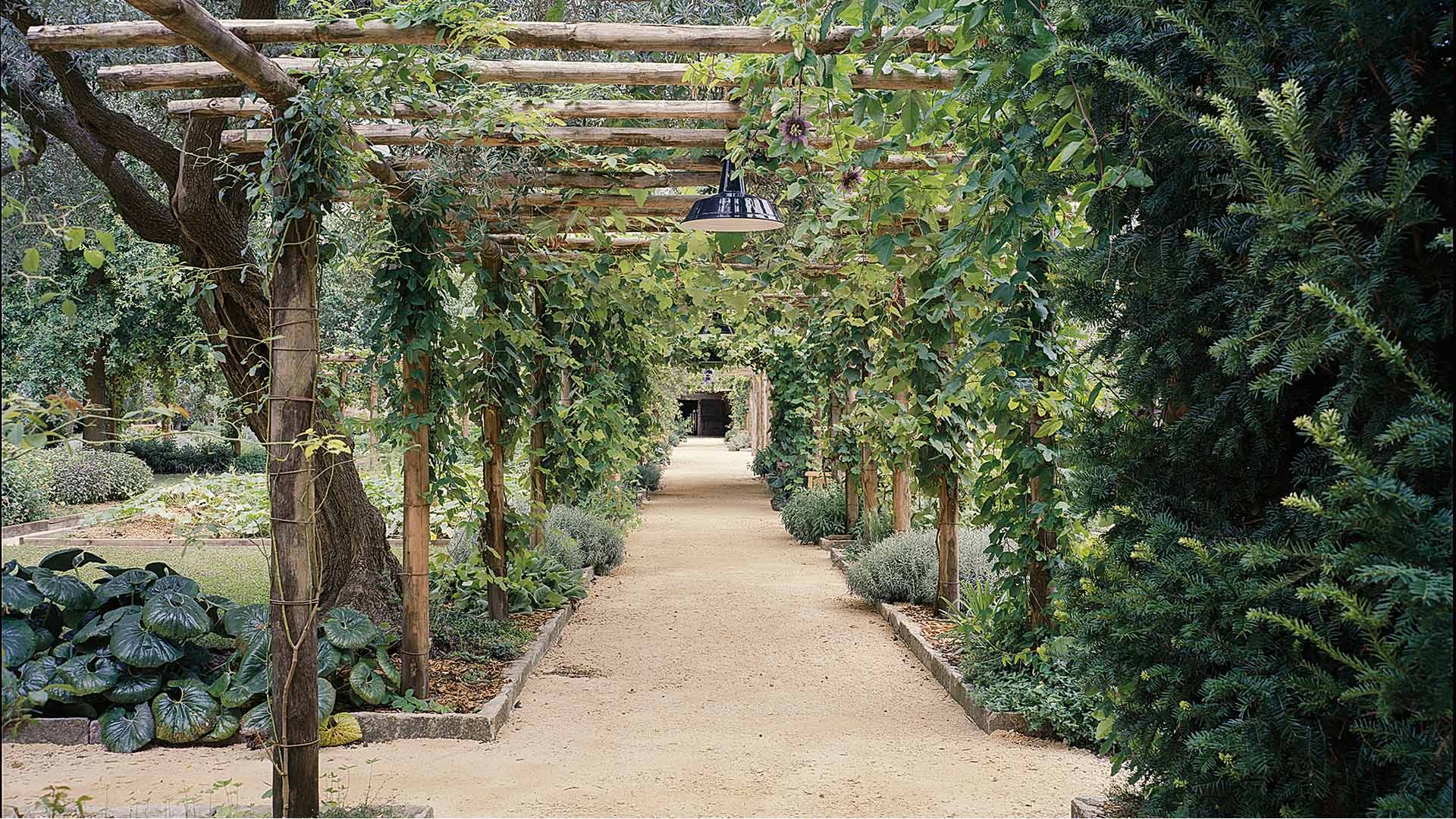
In what conditions was the Compendium, which covers about one hectare from the Giudecca canal up to the Lagoon, when you first saw it?
Let’s say that we are talking about an extraordinary and deeply symbolic place, linked to the spirituality of the Capuchin Friars, with a history of 500 years, never open to the public before.
The Convent is annexed to the Church of the Redeemer, which was commissioned to Andrea Palladio by Pope Gregory XIII and the Serenissima as a vow for the end of the plague of 1575-1577, a true symbol of rebirth. The Compendium includes not only the Vegetable Garden, but also the Meditation Chapels, the Greenhouse, the Apiary and the ancient Workshops. The latter which overlook the Vegetable Garden to the north and the Lagoon to the south, were used by the friars as a carpentry, workshop, wool mill – here the friars’ habits were made – and also as a place to prepare the mistrà, a liqueur mixed with water, offered on the occasion of the Feast of the Redeemer. In May 2021 the Curia of the Venetian Province and the Capuchin Friars entrusted the whole Compendium to the Venice Gardens Foundation with the authorization of the Holy See and the Superintendence. Both the botanical part of the garden and the buildings had been severely damaged by the passing of time and by the Acqua Granda of 2019, which devastated the whole city. No intervention had been made after this catastrophic event. Degradation was evident and the problem of salinity, both on the walls of the buildings and in the ground, was very critical.
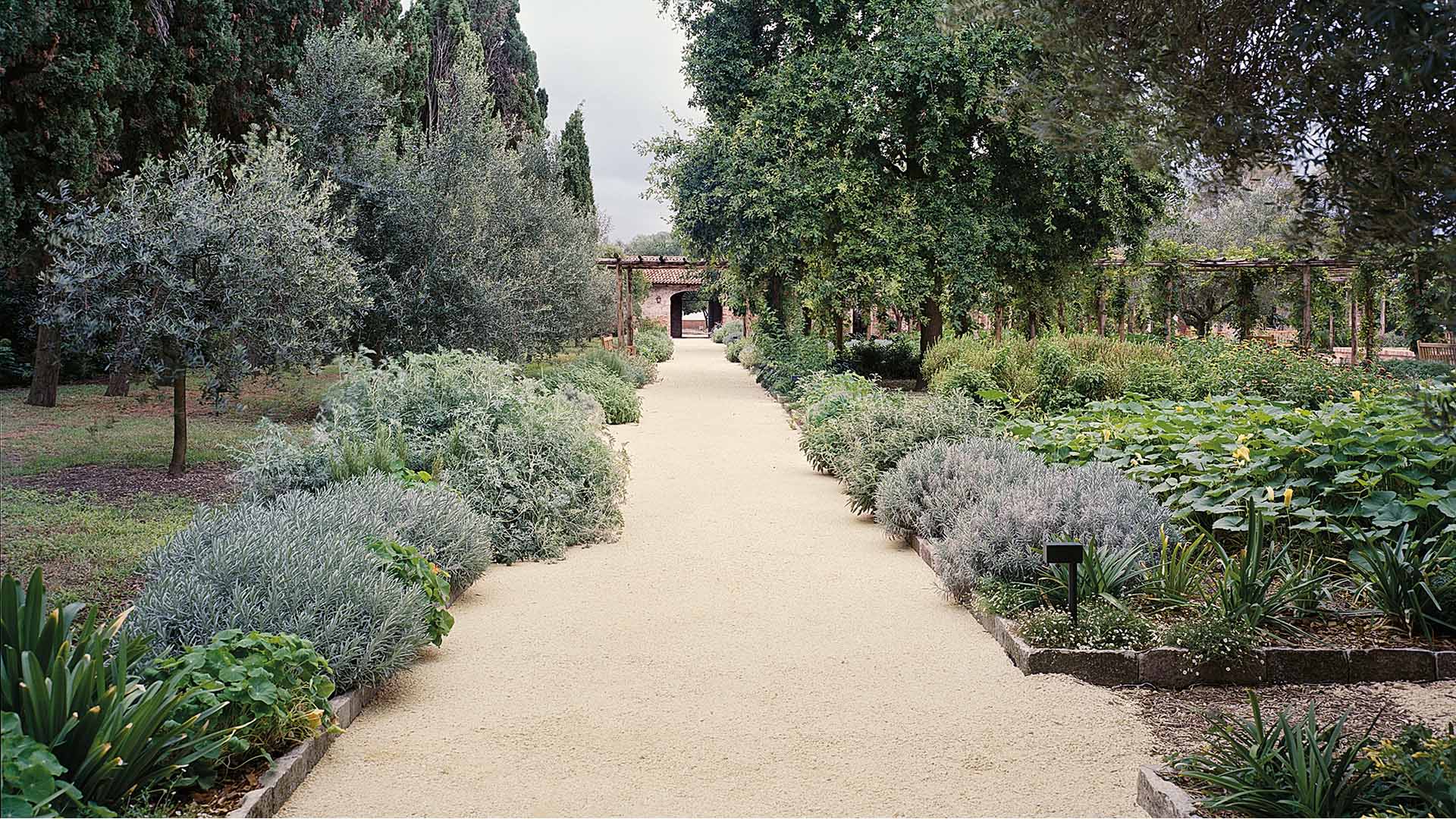
A highly qualified team of experts has been involved for the Garden of the Redeemer too. What is the key to the project?
Venice Gardens Foundation, in order to give back all its beauty to this place and to envisage a future for it, has developed a project based on an in-depth archival research leading back to the important tradition of conventual gardens, their richness and capacity for experimentation. The project was entrusted to the internationally renowned landscape architect Paolo Pejrone. The restoration of the botanical, artistic and architectural heritage has followed a conservative and extremely philological approach. The project has focused on the restoration of the original layout of the Garden based on the symbolism of the cross, already present in the 17th century, as shown in Giovanni Merlo’s map of Venice dating back to 1696, with a network of pergolas in debarked chestnut wood that define the spaces of the different crops: vegetable garden, orchard, olive trees, which once provided livelihood to the Convent itself, with a pool of water lilies in the middle. The Garden of the Simples, where medicinal herbs were grown for the ancient pharmacy of the Redeemer, has been restored, as well as the Garden of Flowers, whose original purpose was to decorate the altars, while today it becomes a primary source of nourishment for the bees of the Apiary. We have also recreated an apiary with three different types of natural honeycomb hives. In collaboration with Paolo Fontana, a specialist in the field, a comparative research will be conducted on the well-being of bees and the quality of honey. When you visit this place it is evident that the garden is made up not only of plants, but also of animals and you can perceive how these living beings are more indispensable for the natural balance than we are. On the banks of the Lagoon, an amazing place to admire the sunset, in the shade of the compact and evergreen foliage of pittosporum plants, with grass and flowers, a secluded area opens up, while on the water front a second pergola is surrounded by Rose banksiae “Alba Plena”, in contrast with the other pergola, covered with grape plants and roses, wisteria and bignonia. The restoration of the buildings, under the supervision of architect Alessandra Raso, was also carried out with the same philological care. These are simple buildings, in line with the rule of St. Francis of Assisi. The internal and external walls over time had been covered by layers of concrete, which were removed using small chisels, bringing to light the original brick, which was later treated with anti-senility compresses. The same attention was paid to the Meditation Chapel, a twelve square meters space where peace and silence reign; a place where you don’t need to do anything, just stop and listen to your inner self.
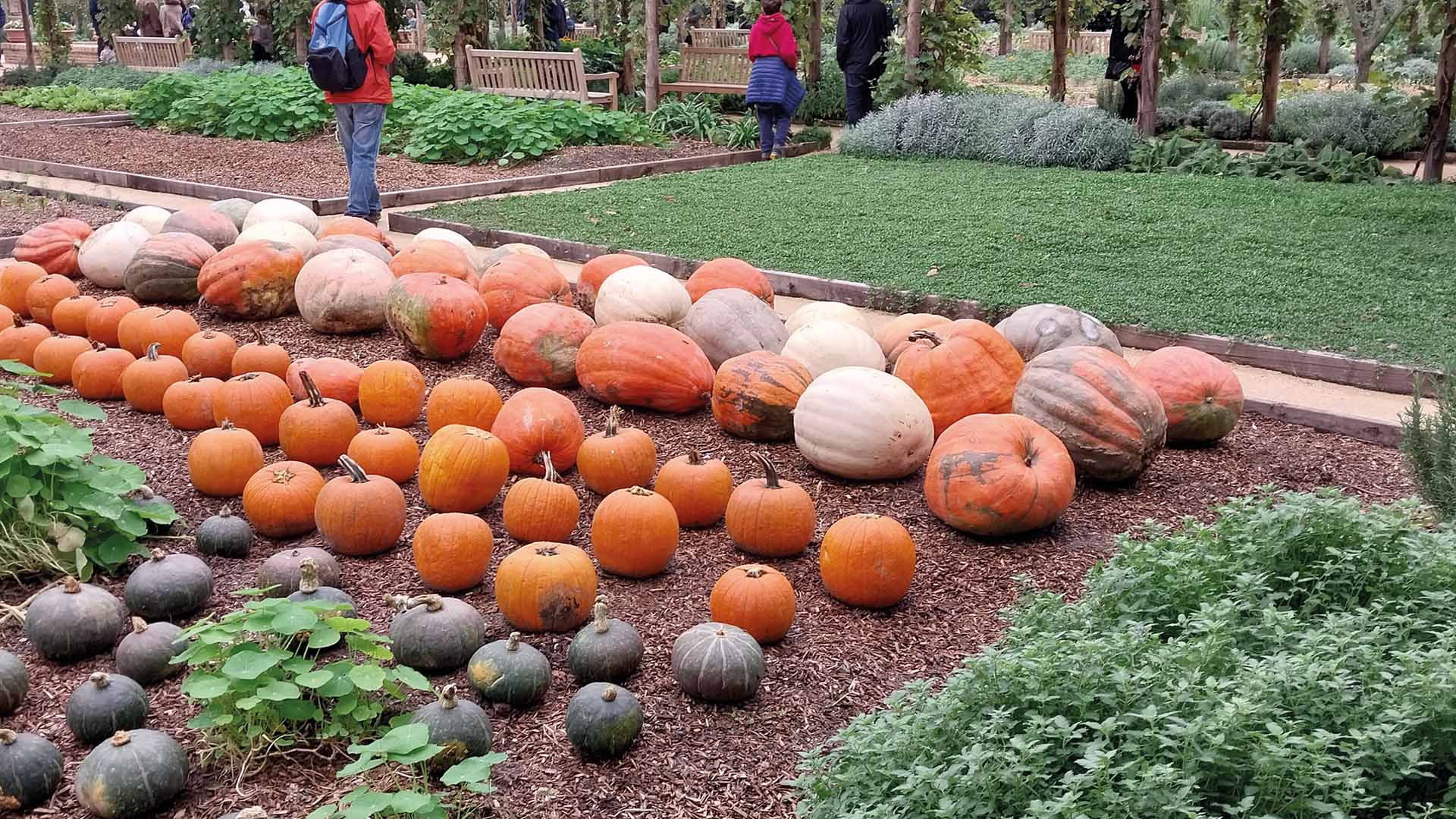
Garden, vegetable garden, meditation chapels, ancient workshops, greenhouse, apiary of the convent of the Most Holy Redeemer Church. What was the symbolic meaning of this place?
The Compendium responds to the principles of poverty, simplicity and functionality established in the Capuchin constitutions, with an extensive and complex garden, or rather a hortus in the Latin sense, referring to a beautiful and useful green space, with a plant heritage including fruit trees, flowers, vegetables and medicinal plants, in line with the roles traditionally played by the various religious Orders. Its location, surrounded by the Lagoon, the Convent and the boundary walls, qualifies it as a hortus conclusus, an articulated and well-defined space, capable of performing multiple functions. The most important one for Capuchin spirituality, closely linked to the Franciscan Canticle of the Creatures, is the idea of an anticipation of Paradise: the harmony between nature and man creates a joyful and perfect place also here on earth.
An ambitious and extraordinary project involving qualified partners, many of them playing the role of precious financiers.
In Venetia Hortus Redemptoris, this is the official title of the project, was also made possible thanks to the institutions foresight and to the generosity and vision of various patrons, who were able to create a close relationship with this place of high historical and spiritual value in order to contribute to its restoration, protection and conservation. The project partners are: European Union NextGenerationEU, Ministry of Culture – Superintendence of Archaeology, Fine Arts and Landscape for the Municipality of Venice and its Lagoon, Fondazione di Venezia, Friends of Venice, Generali, Intesa Sanpaolo, The Guillon Family of Fondation Valmont, The Roger Thomas & Arthur Libera Family Foundation, The Venice International Foundation, Van Cleef & Arpels, Airelles, Fondazione Cologni Mestieri d’Arte, Fondazione Hillary Merkus Recordati, Siram Veolia, Luca Bombassei, Franca Coin, Massimo Sordella. It is thanks to their support that today we can discover and enjoy an area of such extraordinary beauty and depth.
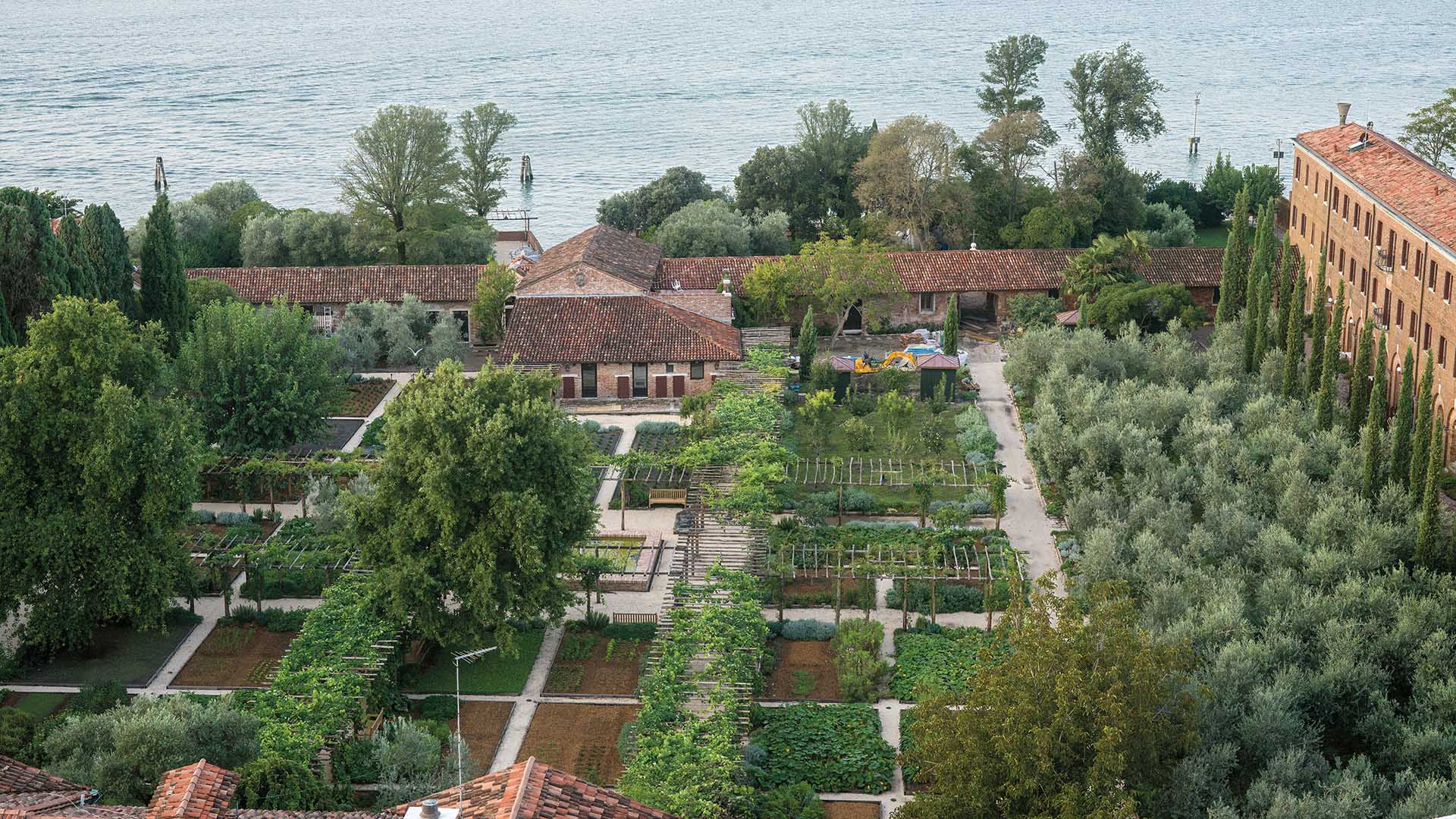
What will be the new Garden impact on the city’s social and cultural economy?
The Vegetable Garden of the Redeemer will be open to the public from Thursday to Saturday, at different times depending on the season. Unlike the Royal Gardens, which are free, you have to buy a ticket to visit this garden in order to help support the costs of management and maintenance. In order to promote the social and community role of this place, Venetians will enjoy a reduction or a membership card at only 30 euros per year. A subscription that will contribute directly to the maintenance of the garden and that we hope will help visitors to be more responsible, encouraging them to take care of such a precious place.
The Antiche Officine – The Ancient Workshops – will host exhibitions in harmony with the garden essence. We have already involved two artists: Remo Salvadori, who created a beehive that welcomes visitors at the entrance of the Compendium, and Lucia Veronesi, who made a video that tells the various moments of the restoration. In addition to these two important works, Guido Guidi’s and Francesco Neri’s photographs are an exhaustive documentation of the restoration works. In some periods of the year, the Antiche Officine will also host the oil mill and the honey extraction room for the on-site production of our oil and honey. The Vegetable Garden will in fact produce oil, honey, vegetables, medicinal herbs, herbs and flowers. A coffee shop, run by Illy, will offer our products practically at “zero meter” considering that they mostly come straight from the vegetable garden. This space will be open as well to botanical, scientific and artistic research including different disciplines such as nature-theatre, musical and literary works, poetic narratives and polyphonic songs. Workshops for children will also play an important role aiming to develop in the little ones, through knowledge, a deep and lasting relationship with nature. It’s more about responsibility than sustainability. When we fall in love with a living being, whether it be a plant or an animal, we take care of it, defend it, preserve it and doing so we discover that his life is closely linked to ours.